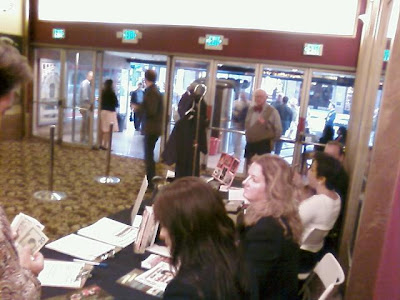

Tonight was my last night for this year's Last Remaining Seats movie series by the Los Angeles Conservancy. They're actually putting on one more film next week, the German silent film Pandora's Box at the Orpheum, but I'll be in Jersey visiting my father. We're taking a field trip to Gettysburg during the battle's anniversary (July 1-3). In fact, that'll be one of next month's blog posts.
Tonight they showed A Streetcar Named Desire at the Los Angeles Theatre, one of my favorite Broadway theaters downtown. Just look at the photos below. You'll see why. Per my custom, I got downtown early so I could have some drinks and dinner ahead of the show. Unlike past weeks, I wasn't in the mood to try a new joint, so I went to the Library Bar. Only, instead of the Library Burger, I had the Hickory Burger, which is actually very similar, only it has, you know, hickory sauce. And a different kind of cheese. And I got those peppered steak fries with the hickory dip sauce again. God....DAMN those are good! I also tried some of the other beers they have on tap. Yes I got the 1903 Prohibition Ale like I always do, but I also tried the Craftsman Hef and the Arrogant Bastard. It was too much. I wasn't exactly drunk when I stumbled out of there, or else I wouldn't've remembered much about tonight at all. But I was more buzzed than I wanted to be. No matter. Hey, in the film Blanche indulges in the sauce, doesn't she? I was just getting into the spirit of the film!
After Linda Dishman came out and did her usual thing with thanking all the sponsors, they showed a ten-minute cartoon from the early fifties called Duck Amuck. It was cute. Produced by Chuck Jones and voiced by the great Mel Blanc, it's basically a series of cleverly-drawn conflicts between Daffy Duck and the mysterious animator. The animator starts out drawing and redrawing Daffy in all these different environments. He draws Daffy with a guitar, but no sound comes out, so Daffy holds up a sign that says "Sound Please." And then the animator does things like draw Daffy in a sailor suit, but instead of putting him on a ship, which Daffy hopes for, the animator puts him on a volcanic island. Daffy promptly falls into the volcano. He's also drawn in a WWII fighter plane. The animator draws a mountain just in time for Daffy to fly into it. Don't worry! He parachutes to safety. Anyway, finally at the end Daffy demands to know who in tarnation is making his life so difficult. Who do you think it is? When the animator is revealed, it's none other than Bugs Bunny! "Ain't I a stinka?" Oh Bugs, but that's why we love you!
After that, the lights came back up, and this guy came out on stage to give a lecture. He was an older guy named Leith Adams. According to the program, he's the corporate archivist at Warner Brothers. The main point of his lecture was the long and twisty road Streetcar took to achieve true success. Although I don't know, it seems to have done just fine right out of the gate. The play on which it was based had its premier on Broadway. How many plays premier on Broadway? Not many. Tennessee Williams was in his mid thirties or so and was already a theatrical force to be reckoned with. He'd written The Glass Menagerie just a couple years before. Streetcar was an instant smash. It won the Pulitzer, played for two years, and saw simultaneous productions in places like London's West End. A movie adaptation was a no brainer.
Elia Kazan, who directed it on Broadway, also directed the movie version. How could he mess it up? Well, he didn't. The film was nominated for twelve Oscars and won four: Best Supporting Actor and Actress for Karl Malden and Kim Hunter, Best Actress for Vivien Leigh, and Best Art and Set Direction for Richard Day and George James Hopkins.
Nah, the critics were never a problem for the play or the film. It was the censors who had to make things complicated. The way Leith explained it, the first set of obstacles came when the play was still being adapted. In the original play, Blanche's late husband committed suicide after she found out he was having an affair with another guy. But that didn't fly with the Hollywood censors, so in the movie he killed himself because she just plain didn't like him. Also, the ending in the play is much more ambiguous. I won't give it away, but in the movie, it's pretty clear where Stella and Stanley are headed in their relationship.
But even with those and other story changes, the movie still wasn't safe. Whether you see the play or the film, one of the things that strikes you is what a sensual story it is. I mean come on. You've got that Southern heat permeating everything and everyone, with humidity that'll make you sweat no matter how close to the fan you get. Plus, all of the characters are at some extreme emotional state. Everyone's on edge in one form or another. So you've got all this tension, all that sweat, hot women like Stella and Blanche not wearing very much. If you're a Catholic, Streetcar is anathema. Leith talked about the Catholic Church actually banning the film categorically. Cities with majority Catholic populations wouldn't show it in their theaters. Sorry, Boston and Chicago.
Perhaps the most fascinating instance of censorship (or the futility thereof) that Leith talked about was the famous "Stella!" scene. First, he showed the scene that made it into the final film. And then he showed the original, pre-censor version. Hilarious! I mean it was basically the same. The main differences were that in the pre-censor version, they had a kind of sexy jazz music, horns with attitude. And there were a couple camera angles that showed off Stella's figure. I don't know. In this day and age, it seems like a whole lot to do about nothing. But maybe in the fifties, the Hollywood censors felt they had a job to do, and a thankless one at that, I'll be bound.
Another thing Leith talked about that had nothing to do with the censors but was still interesting was how all of the talent from the original Broadway production made it to the film version...except Jessica Tandy. She played Blanche, but in the film, of course, Blanche was played by Vivien Leigh. Now why, you may ask? I liked Jessica Tandy. Mind you, due to when I was born, I didn't discover her until eighties and nineties films like Cocoon and Driving Miss Daisy. Still, I know talent when I see it, so I wasn't surprised at all when I eventually found out she'd had a long and distinguished career. I wonder if she was bitter about not getting the film role for Blanche, especially after Vivien Leigh won her Oscar. Well, whatever. If she was as classy as she seemed, then no. But still, what a role! It wasn't exactly new to Vivien Leigh, by the way. While the Broadway production was still going in the late forties, another production of Streetcar was going strong in London's West End, with Vivien Leigh playing Blanche, directed by her husband Laurence Olivier.
While he's the corporate archivist at Warners, Leith wasn't the one who restored this film. I forget the guy's name behind this restoration, but I remember Leith saying that this guy just turned eighty-eight. Leith called him this morning and told him that the restored version was going to be shown at the Los Angeles. "Great film!" was all the guy said in response. Leith went into the various chemical compounds that this eighty-eight year old had experimented with to figure out what was best for the film's preservation.
Leith talked about how Tennessee Williams was part of a Mississippi tradition of great writers. Was there something in the water that one state could produce the likes of Tennessee Williams, William Faulkner, and Harper Lee? Ooops, he sort of got it wrong with Harper. She was from Alabama, not Mississippi. You might think that's splitting hairs, but not really. Check out Mississippi's flag.
Leith also talked about how producers had package deals at that time. In this instance we'd be talking about Charles K. Feldman, who was a talent agent before a producer. Charles scored a deal with Warner Brothers for Streetcar's 1951 release. Again, the film was critic proof, but it was censored to the bejesus and didn't play nearly as far and wide as it could've. As Leith said, "Warners didn't know what to do with it." So the film was all but stillborn. It wasn't until 20th Century Fox scooped it up seven years later that it got the distribution it deserved. How weird. Nowadays if a film doesn't get much silver screen time, it'll end up on DVD soon enough and that's that.
Another fascinating thing about Leith's lecture is what he didn't say. First off, yes he did talk about Marlon Brando's acting and how his method style changed acting forever. What makes it all the more amazing is that Marlon hadn't done much of anything before this, at least in film. He was in his early twenties and was just starting out. And he flipped acting on its head forever. I saw Streetcar at the ArcLight Hollywood a few years ago as part of their AFI series. I already knew the story about Marlon. And actually it wasn't his style of acting per se, but a style advocated by Stanislavsky, to which Elia Kazan also subscribed. But Leith didn't say a peep about the much juicier story surrounding Elia Kazan.
Born in Turkey when it was still called the Ottoman Empire, Elia Kazan cooperated with the House Un-American Activities Committee and named names. Many innocent screenwriters and directors watched their careers crumble thanks to this guy. But then at the Oscar ceremony in 1999, when the poor guy was ninety, they decided to give him an honorary Oscar. Don't you know that was a very divisive decision. I remember watching that from my apartment at USC. They showed Ed Harris and his wife Amy Madigan not applauding. Others didn't applaud, but a bunch of people did. It was weird. Technically you're supposed to separate an artist from his art, but the Cold War is such a strong part of who we are and what our country is.
Leith never talked about Elia Kazan's conflicted legacy. He just talked about Marlon Brando reinventing acting and Elia Kazan being a storytelling master. That was kind of disappointing, I have to admit.








































